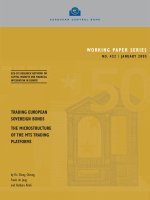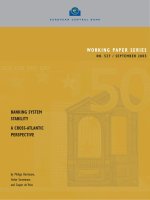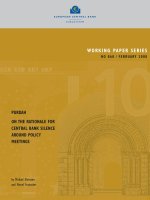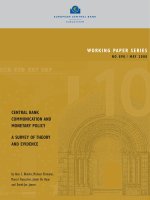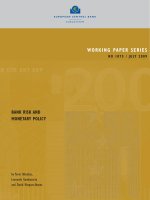WORKING PAPER SERIES NO 1394 / NOVEMBER 2011: BANK RISK DURING THE FINANCIAL CRISIS DO BUSINESS MODELS MATTER? pot
Bạn đang xem bản rút gọn của tài liệu. Xem và tải ngay bản đầy đủ của tài liệu tại đây (1.44 MB, 53 trang )
WORKING PAPER SERIES
NO 1394 / NOVEMBER 2011
by Yener Altunbas,
Simone Manganelli
and David Marques-Ibanez
BANK RISK DURING
THE FINANCIAL
CRISIS
DO BUSINESS
MODELS MATTER?
MACROPRUDENTIAL
RESEARCH NETWORK
1 We are grateful to Thorsten Beck, Gert Bekaert, Giancarlo Corsetti, Andrew Ellul, Philipp Hartmann, Florian Heider, Harald Hau, Harry Huizinga,
Jose Peydro, Alexander Popov, Alberto Franco Pozzolo, Philipp Schnabl and an anonymous referee for useful comments and/or earlier
discussions. We are also grateful to Katerina Deligiannidou, Francesca Fabbri and Silviu Oprica for their help obtaining data.
We thank for their insights to participants at the seminar held at Tilburg University and the European Central Bank.
2 Centre for Banking and Finance, University of Wales, Bangor, Gwynedd, LL57 2DG, UK; e-mail:
3 European Central Bank, Financial Research Division, Kaiserstrasse 29, D-6031, Frankfurt am Main, Germany;
e-mails: and
This paper can be downloaded without charge from or from the Social Science
Research Network electronic library at />NOTE: This Working Paper should not be reported as representing
the views of the European Central Bank (ECB).
The views expressed are those of the authors
and do not necessarily reflect those of the ECB.
WORKING PAPER SERIES
NO 1394 / NOVEMBER 2011
BANK RISK DURING
THE FINANCIAL CRISIS
DO BUSINESS MODELS MATTER?
1
by Yener Altunbas
2
, Simone Manganelli
3
and David Marques-Ibanez
3
In 2011 all ECB
publications
feature a motif
taken from
the €100 banknote.
MACROPRUDENTIAL
RESEARCH NETWORK
© European Central Bank, 2011
Address
Kaiserstrasse 29
60311 Frankfurt am Main, Germany
Postal address
Postfach 16 03 19
60066 Frankfurt am Main, Germany
Telephone
+49 69 1344 0
Internet
Fax
+49 69 1344 6000
All rights reserved.
Any reproduction, publication and
reprint in the form of a different
publication, whether printed or produced
electronically, in whole or in part, is
permitted only with the explicit written
authorisation of the ECB or the authors.
Information on all of the papers published
in the ECB Working Paper Series can be
found on the ECB’s website, http://www.
ecb.europa.eu/pub/scientific/wps/date/
html/index.en.html
ISSN 1725-2806 (online)
Macroprudential Research Network
This paper presents research conducted within the Macroprudential Research Network (MaRs). The network is composed of econo-
mists from the European System of Central Banks (ESCB), i.e. the 27 national central banks of the European Union (EU) and the Euro-
pean Central Bank. The objective of MaRs is to develop core conceptual frameworks, models and/or tools supporting macro-prudential
supervision in the EU.
The research is carried out in three work streams:
1. Macro-fi nancial models linking fi nancial stability and the performance of the economy;
2. Early warning systems and systemic risk indicators;
3. Assessing contagion risks.
MaRs is chaired by Philipp Hartmann (ECB). Paolo Angelini (Banca d’Italia), Laurent Clerc (Banque de France), Carsten Detken
(ECB) and Katerina Šmídková (Czech National Bank) are workstream coordinators. Xavier Freixas (Universitat Pompeu Fabra) acts
as external consultant and Angela Maddaloni (ECB) as Secretary.
The refereeing process of this paper has been coordinated by a team composed of Cornelia Holthausen, Kalin Nikolov and Bernd
Schwaab (all ECB).
The paper is released in order to make the research of MaRs generally available, in preliminary form, to encourage comments and sug-
gestions prior to fi nal publication. The views expressed in the paper are the ones of the author(s) and do not necessarily refl ect those
of the ECB or of the ESCB.
3
ECB
Working Paper Series No 1394
November 2011
Abstract
4
Non-technical summary
5
1 The transformation of the fi nancial system
and its impact on business models and bank risk
10
2 Bank risk and business models:
a literature review
12
2.1 Capital structure
12
2.2 Asset structure
13
2.3 Funding structure
14
2.4 Income structure
15
2.5 Additional control variables
16
3 Model and data
17
3.1 Construction of bank risk variables
18
3.2 Bank business models
19
3.3 Ex-post measures of managerial abilities
21
3.4 Additional controls
23
4 Results
25
4.1 Probit and linear regressions
25
4.2 Robustness
28
4.3 Regression quantiles: a more nuanced
consideration of the determinants
of bank distress during a crisis
28
5 Conclusion
32
References
34
Tables and fi gures
41
CONTENTS
4
ECB
Working Paper Series No 1394
November 2011
Abstract
We exploit the 2007-2009 financial crisis to analyze how risk relates to bank business
models. Institutions with higher risk exposure had less capital, larger size, greater reliance
on short-term market funding, and aggressive credit growth. Business models related to
significantly reduced bank risk were characterized by a strong deposit base and greater
income diversification. The effect of business models is non-linear: it has a different impact
on riskier banks. Finally, it is difficult to establish in real time whether greater stock market
capitalization involves real value creation or the accumulation of latent risk.
JEL classification: G21; G15; E58; G32
Keywords: bank risk, business models, bank regulation, financial crisis, Basle III
5
ECB
Working Paper Series No 1394
November 2011
Non-technical summary
One of the main reasons for the existence of banks is that they are better than other institutions
at evaluating and managing risks. The recent crisis gave way, however, to the largest
materialization of bank risk since the great depression. Precisely the special role of banks as
evaluators of risk makes the banking sector a particularly opaque industry. This opacity has
probably increased in recent years due to structural changes in the banking industry brought
about by de-regulation and financial innovation. These changes made the banking industry
significantly more complex, larger, global and dependent on financial markets’ developments.
We exploit the advent of the crisis to analyze whether the variability across banks business
models can be related to the materialization of bank risk during the period of the crisis.
For a large sample of listed banks operating in the European Union and the United
States, we compute different measures of realized bank risk – namely the likelihood of a bank
rescue, systematic risk and the intensity of recourse to central bank liquidity. We then consider
how these variables are related to a range of pre-crisis individual bank information obtained
from a manually-assembled database.
We find that credit expansion, lower dependence on customer deposits, size and weaker
capital (especially for undercapitalized banks) in the run up to the crisis accounted for higher
ex-post levels of distress. Other factors, including the amount of market funding and lack of
diversification in income sources also contributed to an increase in realized bank risk.
Accounting for macroeconomic and institutional factors – including the role of deregulation,
economic cycle, competition and asset prices developments – do not change the gist of our
results. In line with Rajan (2005) and Acharya, Pagano and Volpin (2011), our results also
suggest that it is difficult to disentangle ex-ante among the different reasons for the creation of
stock market value: we find that for some banks the large increases in stock market values
prior to the crisis took place on the back of the creation of latent systematic risks whereas for
others institutions it reflected relative managerial ability.
A second contribution of this paper is to show, using regression quantile techniques,
that the impact of business models is highly non-linear. The level of distress of the riskier
banks is more sensitive to loan growth, customer deposits and market funding. More precisely,
a stronger customer deposit base is relatively more effective in reducing distress for the riskier
6
ECB
Working Paper Series No 1394
November 2011
compared to the less risky banks. Similarly, a higher proportion of market funding increases
the likelihood of distress of the riskiest banks although it has no effect on the less risky
institutions.
In relation to prudential regulatory initiatives undergoing at the global level via Basle
III, our results are in line with Basle initiatives aimed at raising the core capital levels of
institutions and in particular of undercapitalized ones. They also concur with efforts directed at
reducing the cyclicality of credit and increases in the capital charges of those institutions
relying more strongly on short-term market funding. Given its quantitative importance, a
careful assessment of the implementation of the anti-cyclical capital buffers proposed by Basle
III is warranted. For instance our results show that excessive loan growth seems to be a very
good leading indicator of bank risk so that capital charges linked to this variable might be
considered.
7
ECB
Working Paper Series No 1394
November 2011
In cauda venenum
1
The 2007-2009 financial crisis resulted in the largest realization of bank risk since the
Great Depression. The decimation of the market value of banking shares during this period
was unprecedented: more than 3 trillion euros were erased from the market capitalisation of
banks in Europe and the United States. This corresponds to a decrease of 82% in the stock
market value of these banks between May 2007 and March 2009. The impact on the real
economy triggered by the problems in the banking sector was extremely severe, producing
record levels of unemployment and giving way to what is now referred to as the “Great
Recession”. However, while the loss in value was widespread, the effects of the crisis were
very diverse across banks. A case in point is provided by the increased dispersion of cross-
sectional stock market returns after the crisis, suggesting a strong degree of heterogeneity
in ex-ante risk-taking (see Figure 1). This paper has three main objectives in this regard.
First, we analyse the impact of different business models on bank distress. Second, we
examine whether this impact is non-linear at the cross-sectional level. Third, we assess
whether the high stock market values experienced by a number of banks prior to the crisis
were actually related to an accumulation of latent risk.
{Figure 1}
For a large sample of listed banks operating in the European Union and the United
States, we measure the risk that materialised during the crisis in three ways: the likelihood
of a bank rescue, systematic risk, and the recourse to central bank liquidity. This
multifaceted approach lends robustness to our results, as it captures the different
dimensions of risk as they unfold during a crisis. We then consider how these variables are
related to the characteristics of individual banks during the pre-crisis period using a
database laboriously compiled for the purposes of this study. We group individual bank
information into four categories – capital, asset, funding, and income structures – which
concisely and effectively summarize the underlying bank business models. We therefore
use the crisis as a laboratory in which risks that were not apparent on bank risk indicators
1
“In the tail (is) the poison” or “To save the worst for last”. Roman aphorism.
8
ECB
Working Paper Series No 1394
November 2011
prior to the crisis are manifested and link the dispersion of the ex-post manifestation of
risks to the ex-ante (i.e. before risk materialized) variability in bank business models.
2
We find that credit expansion, a lower dependence on customer deposits, bank size,
and a weaker capital base (especially for undercapitalised banks) in the run-up to the crisis
accounted for higher levels of ex-post risk. Other contributing factors include the amount
of market funding used and the lack of diversification in income sources. These results are
robust with regard to the use of different indicators measuring diverse aspects of bank risk.
Taking into consideration macroeconomic and institutional factors – including the role of
deregulation, the economic cycle, competition, and developments in asset prices – does not
significantly alter the main results.
Second, we show that ex-post measures of managerial abilities considerably
augment the explanatory power of the regressions, suggesting that bank business models
still leave a significant portion of risk unaccounted for. In this respect, and in line with
Rajan (2005), our results suggest that for some banks the large market-to-book values
attained prior to the crisis occurred on the back of latent systematic risk, whereas for others
it reflected better managerial ability. The results also show that it is difficult to disentangle
ex-ante the different factors behind the creation of stock market value (Rajan, 2005;
Acharya et al., 2011).
Finally, our results also indicate that the effect of business models on bank risk is
highly non-linear. This impact was identified by estimating a quantile regression version of
the baseline specification. This estimation reveals whether the risk determinants of the
riskiest banks (those belonging to the higher quantiles of the cross-sectional distribution of
risk during the crisis) are identical to those of the less risky banks (those belonging to the
lower quantiles of the distribution). In fact, the “riskier” banks were found to be more
sensitive to loan growth, customer deposits and market funding, in terms of their levels of
distress. More precisely, a stronger customer deposit base is relatively more effective in
reducing distress for these banks than for the less risky ones. Finally, a higher proportion of
2
See Beltratti and Stulz (2011); Bekaert et al. (2011); Demirguc-Kunt et al. (2011) for similar applications analysing stock market
performances.
9
ECB
Working Paper Series No 1394
November 2011
market funding increases the probability of distress for the riskiest banks, but has no effect
on the less risky institutions.
Our findings have a bearing on the current prudential regulatory debate. From a
long-term perspective the run-up to the 2007-2009 crisis was characterised by a process of
financial deregulation and rapid innovation, with the widespread use of new financial
instruments. Both of these factors altered the business models as well as the incentives for
banks to take on new risks. The regulatory answer to these incentives, via the initial Basel I
Accord, mostly focused on efforts aimed at applying common minimum capital
requirements related to banks’ credit risk exposures.
3
The Basel II Accord, however, did
not require a minimum common standard for capital charges, but rather allowed large and
sophisticated institutions to use their own internal risk assessment models. With the benefit
of hindsight, the results presented here suggest that the lower reliance on rules, as well as a
stronger dependence on market discipline and self-regulation recommended by the Basel II
Accord, contributed to the build-up of risk by many institutions in the period before the
crisis.
Our results support the Basel III initiatives aimed at raising the core capital levels of
institutions, in particular of undercapitalized ones (See BIS, 2010). They concur with
efforts directed at reducing the cyclicality of credit and increases in the capital charges for
those institutions relying more strongly on short-term market funding. Our findings also
clearly indicate that excessive loan growth leads to the accumulation of risk by banks so the
introduction of capital charges linked to this variable could be considered. In this respect,
and given its quantitative importance, a careful assessment of the implementation of the
anti-cyclical capital buffers proposed by Basel III is recomended.
This paper also suggests that regulators should increase their involvement in and
understanding of bank business models and incentives to take on risk, issues which have
not been explicitly incorporated in Basel III. In particular, regulators need to consider risk-
taking incentives in real time and focus on the potential impact of different business models
on risk. Our findings provide valid reasons for the closer scrutiny of banks experiencing
3
The initial Basel I Accord was triggered by a widespread discontent on the part of regulators with the capital ratios of many banking
institutions, particularly the larger ones, after the 1982 Mexican debt moratorium and the following banking crisis.
10
ECB
Working Paper Series No 1394
November 2011
rapid increases in their stock market valuations, to ascertain whether it is driven by
improved managerial abilities or by increasing the bank’s exposure to hidden risks.
The remainder of this paper is organized as follows. Section I provides an overview
of the transformation of the financial system over the past three decades and the impact that
this has had on bank business models and risk-taking incentives. Section II reviews the
literature on business models and bank risk, while Section III describes the model, data
sources, and how the dataset was constructed. Section IV presents the main empirical
findings, together with robustness tests and further refinements based on quantile
regression techniques. Section V presents conclusions and makes recommendations for
future regulation and research.
I. The transformation of the financial system and its impact on business models and
bank risk
The evaluation, management and sharing of risk is one of the core features of the banking
sector. In fact, a key reason for the existence of banks is that they are better at screening
and managing risks than other institutions, so they can act as delegated monitors for
uninformed depositors (Diamond, 1984). Compared with financial markets, banks are also
better at handling those risks which cannot be diversified away (Allen and Gale, 1997).
Despite this ability, the huge accumulation of risk that subsequently materialized during the
recent crisis raises significant doubts as to whether banks face the right incentives to
manage risk effectively on behalf of depositors and investors. Indeed structural
developments in the banking industry have probably helped distort incentives towards more
risk-taking and a closer dependence on financial markets (Rajan, 2005; Boot and Thakor,
2010).
The first major structural development was deregulation. Over the past 25 years,
there has been a strong process of liberalization of the banking sector in most developed
countries – a development that has also altered incentives to take on risk. In the wake of the
globalization of financial markets, deregulation aimed to achieve economic gains on the
back of greater competition. The result was an unparalleled loosening of the regulatory
constraints on banks; a development that has increased competition and lowered their
11
ECB
Working Paper Series No 1394
November 2011
charter values (Hellman et al., 2000).
4
In the United States this liberalization de facto
dismantled barriers to the geographical expansion of banks and included a far-reaching
deregulation of investment bank activities, prompting the creation of large financial
institutions involved in a broad range of banking activitiesbusinesses.
5
There was a parallel
experience with deregulation in the European Union which (supported by the creation of
the Single Market in 1992 and the introduction of the euro in 1999) removed some residual
regulations limiting certain bank activities.
The second major structural development was financial innovation. Large increases
in the use of direct funding available via the financial markets and securitization activity
formed part of a wider trend of innovation that intensified the trading of credit risk between
banks and financial markets. An important implication of this was that banks became more
integrated with financial markets and increased their share of non-interest income as a
proportion of total revenues derived from own-trading, brokerage and investment banking
activities (Boot and Thakor, 2010).
Deregulation and financial innovation led to a profound change of bank business
models while altering their incentives to take on risks. These changes impacted on several
dimensions, such as: size, recourse to non-interest income revenues, corporate governance,
and funding practices, which, in turn, were all affected by the macroeconomic and
competitive environments.
At the global level, the regulatory response to these enhanced incentives to acquire
new risks concentrated on the Basel recommendations, which focused on capital
requirements as the cornerstone of prudential regulations for banks.
6
Whereas the initial
1988 Basel I Accord set a standardized minimum level of bank capital for all banks, the
Basel II Accord aimed at more closely connecting capital requirements with underlying
banks’ risks. It also lowered the degree of regulators and supervisors involvement in the
4
Deregulation mainly involved the loosening of regulations related to structure and conduct. Structure regulations are primarily
concerned with whether institutions can undertake certain activities (such as those involving the functional separation of institutions,
entry restrictions or discriminatory rules against foreign banks), whereas conduct regulations focus on normative rules specifying
appropriate firm behaviour and business practices, mainly in respect of bank interaction with customers (some typical examples being the
regulations on fees and commissions, deposit and lending rates or branching limitations).
5
One notorious example is the Gramm-Leach-Bliley Act of 1999 in the United States, which repealed the Banking Act of 1933 (the
Glass-Steagall Act) that had previously imposed a separation or “firewall” between commercial and securities-related banking activities.
6
In other words, the general trend was to introduce competition in banking and to contain risk-taking incentives via capital requirements
(Vives, 2000).
12
ECB
Working Paper Series No 1394
November 2011
conduct of banks’ activities by favoring best practices from financial markets. For instance
Basle II allowed a stronger reliance of capital requirements on banks’ internal risk
assessment models and encouraged a greater role for financial markets as a supervisory
disciplining device. A potential side-effect of the Basel II Accord might have been to
compound the problems of cyclicality of the financial system, which were already
exacerbated by ongoing changes in the financial system (Kashyap and Stein, 2004).
Despite the significant build-up of risks arising from these factors, the majority of
the most commonly used indicators of bank risk showed a fairly benign picture in the years
preceding the crisis. Indeed, even the forward-looking measures of bank risk regularly used
by financial institutions, investors, central banks, and regulators to monitor the health of the
financial system remained at very low levels (IMF, 2009; ECB, 2009). In parallel, existing
evidence indicates that there was a convergence or “flattening” in the differences in
performance between banks before the crisis broke (as measured, for instance, by stock
market returns: see Figure 1 above). The crisis, however, revealed huge variability across
individual banks, as evidence by the cross-sectional dispersion of risk indicators, which
widened significantly during this period. This raises the question of whether the variability
in specific bank characteristics, due to their different business models, could have helped in
the early identification of hidden risks, which would only materialize in the long-term or in
the event of a substantial shock.
II. Bank risk and business models: a literature review
A number of studies have focused on the relationship between certain business model
characteristics and bank risk. Already, prior to the crisis, research has focused on the
interaction between risk and a number of key factors: capital (see, for instance, Wheelock
and Wilson, 2000), operating efficiency (Kwan and Eisenbeis, 1997), funding sources
(Demirgüc-Kunt and Huizinga, 2010), securitization and links with financial markets (Boot
and Thakor, 2010; Keys et al., 2008; Mian and Sufi, 2009), corporate governance (Laeven
and Levine, 2009) and diversification (Stiroh, 2010).
7
7
A parallel body of literature has analyzed the impact of bank competition on bank risk (e.g. Boyd and De Nicolò, 2005).
13
ECB
Working Paper Series No 1394
November 2011
During the recent crisis a number of recent studies have focused on the determinants
of performance using stock market information relating to large banks. Beltratti and Stulz
(2011), for example, found that banks with more Tier I capital (in countries with stronger
capital supervision) and a higher loan to total assets ratio performed better in the initial
stages of the crisis, while banks with more shareholder-friendly boards performed worse.
8
A larger deposit base and more liquid assets were associated with higher returns
(Demirguc-Kunt et al., 2010). Moreover, banks with stronger internal risk controls also
fared better, while the impact of corporate governance was mixed (Ellul and Yerramilli,
2010; Peni and Vähämaa, 2011).
The focus of our study is exclusively on bank risk. As the realisation of risk is a
complex and multifaceted phenomenon, we consider a number of different risk indicators
to gauge the level of distress that banks experienced. Namely, we analyse: the probability
of a bank rescue, systematic risk, and recourse to central bank liquidity facilities (which
allows for assessing the consistency of our results across risk indicators). The rest of this
section offers a selective overview of the existing literature linking specific aspects of bank
business models with risk. We structure the review by grouping business models into four
main broad categories, used later in our empirical investigation.
II.A Capital structure
As previously highlighted, the period of banking deregulation was partly counterbalanced
by regulators giving bank capital a more prominent role in the prudential regulatory
process, as reflected in the initial Basel Accord on capital standards, and subsequent
amendments. Depending on the particular focus and modelling strategy involved, the
literature offers contradictory results as to the effects of capital requirements on bank risk
(Freixas and Rochet, 2008). In principle, the higher the capital reserves, the stronger the
buffer to withstand losses. Less leverage (more capital) also reduces risk-shifting incentives
from shareholders towards excessively risky projects at the expense of debt holders. This is
specially so in the banking industry where a quasi-flat (i.e. not fully risk-adjusted) deposit
insurance exists creating an incentive for shareholders to optimize the option value of the
8
Idiosyncratic bank performance also seems persistent when comparing this to the previous banking crisis (Fahlenbrach, Prilmeier and
Stulz, 2011).
14
ECB
Working Paper Series No 1394
November 2011
deposit insurance by taking on excessive risks (Bhattacharya and Thakor, 1993). Recent
studies on bank capital also analyze the possibility of asset-shifting in favor of riskier
assets, where moral hazard considerations play a role. These generally find that a higher
level of capital is also conducive to a more intensive screening of borrowers and, therefore,
less bank risk (Coval and Thakor, 2005; Mehran and Thakor, 2011).
Nonetheless, a positive relationship between capital and risk can also exist. More
specifically, agency problems between shareholders and managers can lead to excessive
risk-taking via managerial rent-seeking. According to the corporate finance literature,
increasing leverage reduces agency conflicts between managers and shareholders since
informed debt holders intensify the pressure on bank managers to become more efficient
(Jensen and Meckling, 1976; Calomiris and Kahn, 1991; Diamond and Rajan, 2001). A
positive relationship between bank capital and risk can also occur if regulators (or the
markets) force riskier banks to build up capital, or simply if banks with more capital have a
greater risk absorption capacity and, as a result, take on more risk (Berger and Bouwman,
2010). Finally, it is also possible that there is a non-linear relationship and that both very
low and very high levels of capital induce banks to take on more risk (Calem and Rob,
1999).
9
Overall, the empirical literature tends to support the view that more capital
increases bank soundness particularly during periods of crisis and for higher quality (i.e.
core) forms of capital (Gambacorta and Mistrulli, 2004; Wheelock and Wilson, 2000;
Demirguc-Kunt et al., 2010; Berger, and Bouwman, 2010).
II.B Asset structure
Size can be an important determinant of banks’ risk (Huang et al., 2011; Drehmann and
Tarashev, 2011; Tarashev et al., 2009). Compared to smaller banks, larger institutions
could have different incentives due to the “too-big-to-fail” problem or diversification
possibilities (Demirgüc-Kunt and Huizinga, 2010).
Another major factor is securitisation, which enables banks to off-load part of their
loans from the asset side of their balance sheet to financial market investors. The years
9
Acharya, Mehran and Thakor (2010) show that banks face two moral hazard problems – asset substitution by shareholders and
managerial rent-seeking – which require a level of bank leverage that is neither too low nor too high. According to their model, the
optimal capital regulation requires that a part of bank capital be unavailable to creditors upon failure, and be available to shareholders
only contingent on good performance.
15
ECB
Working Paper Series No 1394
November 2011
preceding the crisis also coincided with a rapid growth in off-balance sheet financing by
banks that was supported by the massive expansion of securitisation markets. This changed
banks’ business models dramatically altering their incentives to hedge and take on new
risks (Shin, 2009; Marques-Ibanez and Scheicher, 2010). Structurally, securitization
allowed banks to turn traditionally illiquid claims (overwhelmingly in the form of bank
loans) into marketable securities. The development of securitization therefore allowed
banks to off-load part of their credit exposure, thereby lowering regulatory pressures on
capital requirements and raising new funds. In principle, from the perspective of individual
banks, securitization allowed banks to manage and diversify their credit risk portfolio more
easily, both geographically and by sector. Scant empirical evidence from the pre-crisis
period also went in this direction. In particular, banks that were more active in the
securitization market were often found to have lower solvency risk, higher profitability
levels, and were better capitalized (see, among others, Cebenoyan and Strahan, 2004, and
Wu et al., 2011). However, banks might also respond to the static reduction in risks due to
securitization by taking on new ones; for instance, by loosening their lending standards,
increasing their leverage, or becoming systemically riskier (Mian and Sufi, 2009; Keys et
al., 2010; Nijskens and Wagner, 2011).
II.C Funding structure
The deregulation and financial innovation developments led banks to increase their
dependence on financial markets for their funding. This involved borrowing more
intensively from wholesale markets, where funds are usually raised on a rollover basis
through instruments such as mortgage bonds, repurchase agreements and commercial
paper.
An alternative source of funding is represented by retail deposits, which tend to be
more stable in periods of crisis (Shleifer and Vishny, 2010): since they are typically insured
by the government, their withdrawals in most circumstances are usually predictable at the
aggregate level and mostly linked to depositors’ liquidity needs (Song and Thakor, 2007;
Huang and Ratnovski, 2011). The “stickiness” of deposits is also related to high switching
costs and the transaction services that retail depositors receive from banks (Kim et al.,
16
ECB
Working Paper Series No 1394
November 2011
2003). Deposits, however, are often less flexible in adapting to changes in financing needs,
to fund investment opportunities, compared with wholesale markets.
In terms of the impact of the funding structure on bank risk, most of the earlier
literature pointed to the benefits derived from the use of market financing. Banks can raise
in the interbank markets large new amounts of funding swiftly and at relatively low cost. It
was also argued that, compared to depositors, financial market investors tend to be
relatively sophisticated, and hence they were expected to provide more market discipline
(Calomiris and Kahn, 1991).
10
The recent financial crisis, however, pointed to a “dark
side” of wholesale funding. For instance, Huang and Ratnovski (2008) show that, on the
basis of cheap and noisy signals, wholesale financiers have lower incentives to conduct
costly monitoring. This can trigger the liquidation of solvent institutions due to sudden
withdrawals based on negative public signals. Indeed, the recent crisis has starkly
illustrated that market sources of funding are heavily dependent on market perceptions,
raising doubts concerning the monitoring role of wholesale investors. Recent evidence
suggests that when funding from financial markets became unavailable, or prohibitively
expensive, the market valued more positively those institutions more heavily funded via
customers’ deposits (Beltratti and Stultz, 2011; Demirguc-Kunt et al., 2010).
II.D Income structure
Another consequence of deregulation has been a geographical expansion of a number of
financial institutions, a phenomenon which usually coincides with high rates of credit
growth. Strong credit growth was also fuelled by raised collateral values, due to sharp
increases in housing prices in some countries and the more easily available access to
wholesale funding, linked to financial innovation.
Historically, most systemic banking crises have been preceded by periods of
excessive lending growth (Reinhart and Rogoff, 2009). While macroeconomic and
structural changes, such as increases in banking competition, could affect aggregate
changes in lending, added to these factors, microeconomic dynamics could also play a role.
For instance, individual banks could intend to seize new lending opportunities, expand to
10
The empirical evidence relating to the market discipline of banks (from debt holders in financial markets) is mixed (see Flannery and
Sorescu, 1996, and Krishnan et al., 2005).
17
ECB
Working Paper Series No 1394
November 2011
new geographic markets, or gain market share, loosening credit standards in the process
(e.g. Dell’Ariccia and Marquez, 2006; Ruckes, 2004). Microeconomic evidence from large
international banks suggests that loan growth represents an important driver of risk (Laeven
and Majnoni, 2003; Foos et al., 2010; Keeton, 1999).
The global trend towards more diversification in bank income sources and an
expansion of non-interest income revenues (i.e. those revenues derived from trading,
investment banking, brokerage fees and commissions) has provided banks with additional
sources of revenue (Stiroh, 2010). Such diversification can, in principle, help foster
stability in overall income. At the same time, it is not clear whether the stronger reliance on
non-interest income reduces overall banking risk. Since this type of income tends to be a
more volatile source of revenue than interest rate income, in periods of financial stress
there could be a decline in the traditional sources of revenue, together with an even larger
decline in revenues from fees and brokerage services. It is then possible that the financial
stability benefits that may be obtained from diversification accrue only in cases of minor
idiosyncratic risk, but not in the context of a wider systemic shock.
The empirical evidence for the impact of diversification on bank risk in the U.S. and
around the world is mixed (Stiroh, 2010). A general conclusion from these studies is that
the growing reliance on non-interest income has not been associated with reduced volatility
in earnings (DeYoung and Roland, 2001; Stiroh, 2004), or a decline in bank systematic
risk, as derived from stock market returns (Baele et al., 2007; De Jonghe, 2010).
II.E Additional control variables
While our focus is on bank business models, in the empirical specifications we do control
for a number of variables that account for major macroeconomic and institutional factors,
such as developments in housing and equity markets, competition, and corporate
governance.
The role of macroeconomic variables in relation to bank risk works via lenders’
economic expectations and borrowers’ net worth: increases in borrowers’ collateral values
cause an overall improvement in the perceived creditworthiness of both borrowers and
18
ECB
Working Paper Series No 1394
November 2011
banks. In this situation, there is a greater incentive for banks to ease financial constraints
and increase lending, thereby taking on more risks (Matsuyama, 2007).
The impact of competition on bank risk is ambiguous. Enhanced competition could
lead to greater (and possibly excessive) risk-taking by banks (Jimenez and Lopez, 2007).
This is because increased competition reduces market power which, coupled with limited
liability and the application of flat rate deposit insurance, could in turn encourage banks to
take on more risk (Hellman et al., 2000). In contrast, Boyd and De Niccoló (2005) argue
that the theoretical basis for linking increased competition with greater risk-taking is
fragile. Other recent empirical work is consistent with this view (Boyd et al., 2006; Cihak
et al., 2006). The intensity of bank supervision could also have had an impact on the
amount of risk undertaken (Beltratti and Stulz, 2011). In particular, it is necessary to verify
whether more permissive legislation regarding bank activities could have led financial
intermediaries to take more risks (Barth et al., 2004).
Conflicts between bank managers and owners might also have an impact on bank
risk-taking. In principle, companies with a diversified shareholder ownership advocate
more risk-taking, as each shareholder tends to have a substantial equity stake in the bank
concerned (Laeven and Levine, 2009). Firms with a higher degree of institutional
ownership also appear to have undertaken more risk prior to the crisis, prompting large
losses for their shareholders during the crisis (Erkens et al., 2009).
III. Model and data
In line with the previous discussion, our empirical investigation is based on the following
specification:
ibkbkbibkbi
iibibibibi
bibibibibibici
compreggovernancemacroassetsonreturn
edfalphaedfbetaexlendniincostdebassetsmkt
abstaloansizekregetaetar
controls
,16,15,14,13,12
abilities Managerial
1110
structure Income
,9,8
structure Funding
,7,6
structureAsset
,5,4,3
structure Capital
,,2,10,
__
___
_*_
(1)
19
ECB
Working Paper Series No 1394
November 2011
The dependent variable (r
i,c
) measures the distress of bank i during the crisis period
c (2007Q4 to 2009Q4),
11
while the regressors include the averages for bank characteristics
and for controls in the pre-crisis period b (2003Q4 to 2007Q3). The use of average
information for the pre-crisis period serves to minimize short-term distortions in bank
characteristics, since our main objective is to show whether certain medium or long-term
business characteristics present in the pre-crisis period can be systematically linked to the
risks that materialised during the financial crisis. By combining information from the pre-
crisis period and the manifestation of risk during the crisis, we are able to minimize
endogeneity problems by using the crisis as a laboratory (see Beltratti and Stulz, 2011;
Bekaert et al., 2011; Demirguc-Kunt et al., 2011).
The statistical sources used and a brief description of the main variables included in
our study are provided in Table I, while Table II shows the main descriptive statistics. Our
initial dataset had more than 1,100 listed banks from 16 countries; namely: Austria,
Belgium, Denmark, Germany, Greece, Finland, France, Ireland, Italy, Luxembourg, the
Netherlands, Portugal, Spain, Sweden, the United Kingdom, and United States. The final
dataset comprises only listed banks (which typically adhere to international accounting
standards) for which all the necessary information was available. From a macroeconomic
point of view, it is highly representative, as it covers around two-thirds of the total
aggregate balance sheet of banks operating in the European Union and United States. The
rest of this section describes in detail the construction of each variable.
{Tables I and II}
III.A Construction of bank risk variables
The purpose of our analysis is to identify the main determinants behind the accumulation of
bank risk and its subsequent realization during the recent financial crisis. During a crisis,
11
Hence, our sample horizon excludes the period of tension in sovereign bond markets. This is because the spillover effects on the
banking sector would distort our model and, thus, our final results. For instance, between 2009 and 2010, the yield for 10-year Greek
government bonds increased from 5.2% to 9.3%, raising the spread with the government bonds of euro area counterparts from 110 basis
points to 530 basis points. This also affected all the indicators of bank risk for Greek banks.
20
ECB
Working Paper Series No 1394
November 2011
however, the appearance of bank risk unfolds progressively and manifests itself in different
dimensions. To ensure that our results do not depend on a specific definition of bank risk,
we employ three alternative measures to capture the different aspects of its realization.
i. Financial support (resc) – Our first measure of bank risk captures whether an institution
received any government support. The construction of this variable is based on the
collection of information relating to the public rescue of banks via capital injections, the
issuance of state-guaranteed bonds, or other government-sponsored programmes. We use
several sources, including the European Commission, central banks, the Bank for
International Settlements, Bloomberg, and the websites of a number of government
institutions.
12
The resulting dependent dummy variable takes the value of one if public
financial support was received during the crisis and zero if otherwise.
ii. Systematic risk (risk) – Our second measure of bank risk is based on the concept of a
bank market exposure during the financial crisis. It is constructed using a simple capital
asset pricing model (CAPM), based on the following equation:
R
i,k,t=
β
i,k,t
* R
m,k,t
+ ε
i,k,
(2)
where R
i,k,t
is the daily logarithmic excess stock market returns for each bank i from country
k at time t;
13
R
m,k,t
is the daily logarithmic excess stock market returns from the broad stock
market index m for country k; and the term ε
i,k,t
is a bank-specific residual. To ensure
comparability, we use the broad stock market index for each country available from
Datastream. For each bank i, we calculate the systematic component β
i,k,t
by running
separate regressions on daily data for every quarter q from 2007Q4 to 2009Q4. We then
calculate the average beta for each individual bank during the crisis period. Because it has
been constructed with data from an extreme event as the recent financial crisis, this
measure captures the dependence of banks on the market in tail periods. Hence, in a cross-
sectional analysis, we are able to detect which banks are relatively more exposed to tail
risks.
14
12
For a comprehensive overview of the public measures in support of the financial sector see Stolz and Wedow (2010).
13
We calculate excess returns as the difference between stock market returns and the 10-year government bond yield for the country
concerned.
14
Acharya et al. (2011), Brownlees and Engle (2010) and Adrian and Brunnermeier (2008) propose more sophisticated although
conceptually similar alternative measures of systemic risk based on stock market information.
21
ECB
Working Paper Series No 1394
November 2011
iii. Central bank liquidity demand (bid) – Our third measure of bank risk is based on
information on liquidity provided to banks by the Eurosystem (i.e European System of
Central Banks, see ECB, 2011). It is constructed as the overall liquidity position of each
institution with the Eurosystem and encompasses two main types of liquidity provision:
weekly main refinancing operations and longer-term refinancing operations, with a
maturity ranging from one month to one year. This overall liquidity exposure is divided by
total assets in order to make the amounts comparable across institutions.
15
Unlike the two
previous measures, this variable also accounts for liquidity risk, covering another aspect of
bank risk that is, in principle, transitory in nature, but which might signal future banking
problems.
III.B Bank business models
We match information on average bank risk during the period of the crisis with data for
bank characteristics from the pre-crisis period (2003Q4 to 2007Q3). We start with the
approximation of business models using a dataset of consolidated quarterly financial
statements obtained from Bloomberg. We then select and group the regressors according to
different bank business models, following the insights gleaned from the literature on bank
risk discussed previously (in Section II). Our aim is to discover whether certain business
models operating in the pre-crisis period could be linked to the emergence of greater risk
during the crisis. Consequently we separate our regressors into four main groups,
accounting for: the bank capital structure (i), asset structure (ii), funding structure (iii), and
income structure (iv).
i. Capital structure – We approximate bank capital by using a ratio of Tier I capital to
total assets (eta). We aim to capture high-quality (i.e. core) equity, such as Tier I capital,
which is expected to be more effective in safeguarding a bank’s financial viability
(Demirguc-Kunt et al., 2011). As already discussed, the impact of capital on the bank’s risk
is ambiguous. It might be negatively related to the probability of distress if it serves as an
ex-ante buffer against potential losses. It could also be positively related to bank distress if
15
We restrict our results to the period of full allotment of liquidity provision by the European Central Bank (starting in October 2008) to
avoid any distortions arising from changes in the central bank operational framework. We include only information on listed banking
groups for which consolidated financial statements are available via Bloomberg. This limits the size of our sample to just 83 banking
groups but these cover, nonetheless, more than 90% of the average liquidity provided by the Eurosystem.
22
ECB
Working Paper Series No 1394
November 2011
it is driven by regulatory or market actions imposing stricter requirements on riskier banks.
In line with Calem and Rob (1998), Perotti et al. (2011) and the proposals made by the
Basel Committee on Banking Supervision (2010), our measure of capital interacts with a
dummy indicator (eta_reg) for banks with low capital ratios (below 6%) to account for the
possible non-linear effect that bank capital may have on bank risk
ii. Asset structure – The first variable characterizing the asset structure is size (size),
measured as the average logarithm of total assets of the consolidated institution before the
crisis. It allows us to capture the effects of diversification and other economies of scope
(such as access to markets) related to reduced levels of risk for larger banks. Alternatively,
larger banks may be more prone to concerns about being “too big to fail”, or be too
complex to manage. They may also suffer more severely from the effects of greater
inefficiencies in their internal capital markets and thus become riskier (Stein, 1997).
A second variable capturing a different aspect of the asset structure is the ratio of
loans to total assets (loan_ta). This provides a summary indication of the extent to which a
bank is involved in traditional lending activities.
The amount of securitization activity (abs) represents another important aspect of
how banks manage their asset structure. However, the impact of securitization on bank risk
is uncertain. Securitization may fulfil a funding function and allow banks to remove credit
risk from their balance sheets and pass it on to investors. Alternatively, it might lead banks
to take on additional risk with the new funds generated or to simply lower their overall
credit standards. Dealogic, an independent data provider, is the source of information on
securitization activity. This data has been matched with balance sheet information made
public by individual banks and then used to calculate the private securitization originated
per quarter by each individual bank as a proportion of total bank assets during the same
period.
16
iii. Funding structure – The third group of regressors is concerned with the structure of
on-balance sheet funding. It accounts for reliance on short-term wholesale funding,
16
We look at individual deal-by-deal issuance patterns in the private securitization market. The advantage of using data on securitization
activity from Dealogic is that the name of the originator, date of issuance and deal proceeds are registered. The sample includes public
offerings of funded asset-backed securities (ABSs) as well as issues of cash flow (balance-sheet) collateralized debt obligations (CDOs).
In other words, the securities included in the sample involve a transfer of funding from market investors to originators so that pure
synthetic structures (such as synthetic CDOs which transfer credit risk only) and public securitization are not included.
23
ECB
Working Paper Series No 1394
November 2011
measured as the ratio of short-term marketable securities to total assets (mkt_assets), which
might make banks more exposed to funding liquidity shocks. We also include the ratio of
retail customer deposits to total assets (dep), as this represents an important component of
the liabilities of traditional commercial banks. In light of the ubiquitous government
deposit guarantees in place, we expect retail deposits to be a more stable source of funding
than wholesale markets. Thus banks with a broader deposit base should be more resilient in
periods of crisis.
iv. Income structure – It captures the two major income drivers of strategic importance to
financial institutions. First, an aggressive lending strategy has traditionally been associated
with a concentration of risk linked to looser credit standards (Dell’Ariccia and Marquez,
2006; Tornell and Westermann, 2002). This is measured as a bank’s average quarterly loan
growth minus the national average (exlend). Second, we capture the degree of income
diversification and the extent to which a bank has moved towards more volatile non-
interest income by calculating their value as a percentage of total revenue (niinc).
17
III.C Ex-post measures of managerial abilities
The run-up to the crisis coincided with an unprecedented increase in the stock market
valuation of bank shares. Essentially, stock market value creation can be associated with
managerial ability or the build-up of latent risk. In other words, the banks’ creation of high
market-to-book values ex-ante (i.e. in the pre-crisis period) could have been due to genuine
managerial ability (“true” alpha) or to the accumulation of hidden risks, generating high
returns in the short-term but making institutions prone to catastrophic losses in the case of
an exceptional event (high “fake” alpha or “hidden” beta). Yet, as Rajan (2005) has
indicated, in most cases it is difficult to measure in real time (i.e. ex-ante) managerial
ability to generate “true” alpha.
18
This was particularly true in the period prior to the crisis
as the profuse use of innovative financial instruments and banking expansion led to the
emergence of new banking models, in which managers had stronger incentives to reap
short-term returns (Acharya et al., 2010). According to Rajan (2005), “true” alpha can only
17
See Stirohl (2010, 2004).
18
A vivid example here is provided by the Anglo Irish bank. This bank, which defaulted after receiving large amounts of government
funding assistance, was previously ranked the world's top performing bank (for the period 2001 to 2005) by Mercer Oliver Wyman, a
consultancy specialising in financial services strategy and risk management. For further details, see “Anglo Irish Bank is world's top
performer” (www.independent.ie), 27 January 2006.
24
ECB
Working Paper Series No 1394
November 2011
be measured in the long-run and with the benefit of hindsight. Thus the realisation of risk
during the financial crisis enables us, with hindsight, to distinguish between value creation
due to “true” alpha and that merely due to the generation of tail risk.
We separate the “true” alpha from the “hidden” beta, by combining ex-ante
information on banks’ market-to-book values with data on their ex-post realization of risk.
We hypothesize that those banks which created high levels of market-to-book value in the
pre-crisis period (i.e. ex-ante) and achieved relatively low levels of risk during the crisis
(i.e. ex-post) were more likely led by more able managers. On the other hand, the
combination of a high ex-ante market-to-book value and high ex-post risk serves to identify
those banks where value creation in the run up to the crisis was mostly driven by a build-up
of latent risk. Figure 2 illustrates our reasoning.
We identify four types of banks in accordance with our main hypotheses. A bank
will exhibit high “real” alpha if it showed a higher than average ex-ante market-to-book
ratio as well as low levels of risk during the crisis – our “good management” hypothesis.
On the other hand, the “fake” alpha hypothesis applies to those banks that were also
creating higher than average market-to-book values ex-ante but which eventually
encountered a high level of risk during the crisis.
{Figure 2}
More precisely, we construct a dummy variable (high_risk
i
ex-post
) which takes a
value of one for those banks that experienced the highest level of risk during the crisis.
These banks are identified by looking at the upper quartile of the cross-sectional
distribution of the average one-year ahead expected default frequencies (edf)
19
for the crisis
period. The edf value, expressed as a percentage, is calculated by combining the financial
statements released by banks with stock market information and material from Moody’s
19
The “expected default frequency” is a forward-looking indicator of credit risk computed by Moody’s KMV based on financial markets
data plus information from company balance sheets and Moody’s proprietary Bankruptcy Database. Here, we employ a different measure
of bank risk that has not already been incorporated into our analysis as a proxy for bank risk. The use of the edf seems appropriate:
although this may have underestimated risk in the pre-crisis period, it was a relatively good predictor of default during the recent credit
crisis (see, for instance, Munves et al., 2009 and Dwyer and Qu, 2007).

